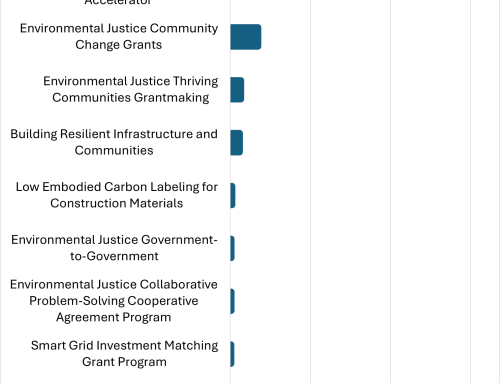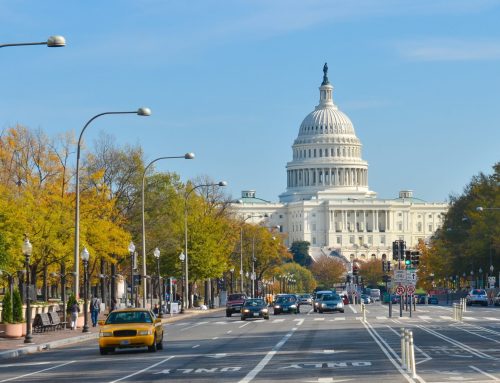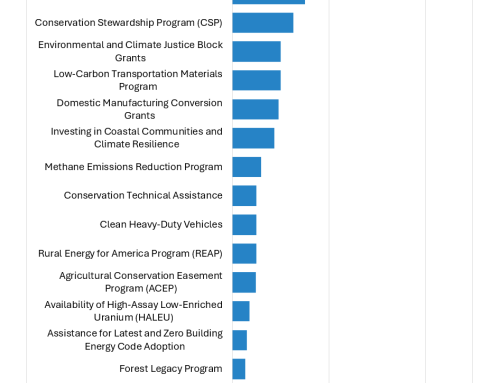
Image Source: Shutterstock.
Eight months into the implementation of the Infrastructure Investment and Jobs Act (IIJA) it’s time to take stock of what we’ve seen so far and what’s still to come. In this month’s spotlight, we provide a progress update on eight of the most significant new climate programs established in IIJA.
We chose these eight programs based on the amount of funding available and their potential climate impact. We will continue to track progress over time to keep you all up to date on the latest developments from IIJA.
Carbon Reduction Program (Section 11403)
The $6.4 billion Carbon Reduction Program will provide formula grants to states to reduce transportation emissions and develop carbon reduction strategies. States have considerable discretion in the type of projects they can fund, ranging from public transportation and congestion mitigation to alternative fuel vehicles, to nonmotorized forms of transportation.
On April 21, 2022, the Department of Transportation (DOT) issued guidance to states and announced funding allocations.
State carbon reduction strategies are due by November 15, 2023.
Promoting Resilient Operations for Transformative, Efficient, and Cost-saving Transportation (PROTECT) program (Section 11405)
The PROTECT program has a total of $8.7 billion available over five years to support planning, resilience improvements, community resilience and evacuation routes, and at-risk coastal infrastructure. Through this program, the DOT will provide $7.3 billion in formula grants and $1.4 billion in competitive grants. On May 31, 2022, the Federal Highway Administration published FY 2022 funding allocations for the formula program.
The Federal Highway Administration expects to release formula program guidance in Summer 2022 and competitive grants in the second half of 2022.
Reconnecting Communities Pilot Program (Section 11509)
On June 29, 2022, the DOT launched the Reconnecting Communities Pilot (RCP) Program. The goal of this $1 billion first-of-a-kind program is to reconnect communities by removing, retrofitting, or mitigating highways or other transportation facilities that create barriers to community connectivity, including to mobility, access, or economic development. In FY 2022, the DOT will award up to $195 million for the RCP program.
Applications are due October 13, 2022. The Department of Transportation held a webinar on July 28 for prospective applicants.
Building a Better Grid (Multiple Sections)
On January 12, 2022, the Department of Energy (DOE) announced the “Building a Better Grid” Initiative which encompasses several different IIJA programs including:
The Preventing Outages and Enhancing the Resilience of the Electric Grid/Hazard Hardening Program will provide grants to strengthen and modernize America’s power grid against wildfires, extreme weather, and other natural disasters exacerbated by the climate crisis. The program is split between $2.5 billion in matching grants for industry and $2.5 billion in formula grants for states and American Indian tribes. The Department of Energy has opened applications for the formula grant portion of the program.
States and Tribes have until September 30, 2022, to apply for their allocations.
The Program Upgrading our Electric Grid and Ensuring Reliability and Resiliency Program (originally called the Electric Grid Reliability and Resilience Research, Development, and Demonstration Program) will provide $5 billion in competitive grants to projects that demonstrate innovative approaches to transmission, storage, and distribution infrastructure to harden and enhance resilience and reliability.
Applications are expected to open in the third quarter of 2022.
The Transmission Facilitation Program is a $2.5 billion revolving fund that will help build out new interregional transmission lines across the country. On May 10, 2022, DOE issued a Notice of Intent and Request for Information for the Transmission Facilitation Program.
DOE intends to release and additional Notice of Intent and Request for Information in Q1 2023.
The Building a Better Grid initiative also includes $3 billion in funding for the Smart Grid Investment Matching Grant Program established under section 1306 of the Energy Independence and Security Act of 2007. IIJA refers to the program as the Deployment of Technologies to Enhance Grid Flexibility Program (Section 40107).
DOE expects to release a funding opportunity by the end of 2022.
Battery Processing and Manufacturing (Section 40207)
The Department of Energy’s Battery Processing and Manufacturing Program encompasses four different programs with a total of $6.135 billion available:
- $3 billion for Battery Manufacturing and Recycling Grants
- $3 billion for Battery Materials Processing Grants
- $125 million for Battery and Critical Mineral Recycling
- $10 million for a Lithium-Ion Battery Recycling Prize
On May 2, 2022, the DOE solicited applications for the Battery Manufacturing and Recycling Grants and the Battery Materials Processing Grants with a total of $3.1 billion available. The Letter of Intent deadline was May 27, 2022, and the full application submission deadline was July 1, 2022.
Awardees are expected to be announced in October 2022 and by November 15, 2022, the DOE must submit a report to Congress on the grant program.
Clean School Bus Program (Section 71101)
The EPA’s Clean School Bus Program provides $5 billion over the next five years to replace existing school buses with clean, zero-emission and low-emission models. Fifty percent of the funds are authorized for zero-emission school buses, and fifty percent of the funds are authorized for alternative fuels and zero-emission school buses. On May 20, 2022, the EPA began accepting applications for the 2022 Clean School Bus Rebate program, which offers $500 million for zero-emission and low-emission school bus rebates.
Applications are due August 19, 2022.
National Electric Vehicle Formula Program (Division J – Title VIII)
The National Electric Vehicle Infrastructure (NEVI) Program will provide a total of $5 billion in formula funding to states to deploy EV charging infrastructure and establish an interconnected network to facilitate data collection, access, and reliability.
States must submit their EV Infrastructure Deployment Plan to the Joint Office of Energy and Transportation. So far, 20 states have released draft plans, 42 states including Washington D.C. have set up a NEVI webpage, and 17 states have open requests to provide feedback and comments on current plans.
State plans are due no later than August 1st, 2022.
Grants for Charging and Fueling Infrastructure (Section 11401)
The Charging and Fueling Infrastructure Grants program has $2.5 billion of funding available. Unlike NEVI, which is a formula program, this is a competitive grants program. Half of the funds will go towards EV charging along designated alternative fuel corridors, and the other half will go towards communities, with priority given to rural areas, low- and moderate-income neighborhoods, and communities with low ratios of private parking. Also, unlike NEVI, this funding is designated broadly for alternative fuels and so may go to hydrogen or natural gas fueling stations as well as electric vehicle charging stations.
The DOT expects to release the funding opportunity later this fall.
What other programs are a high priority for you? Get in touch.


